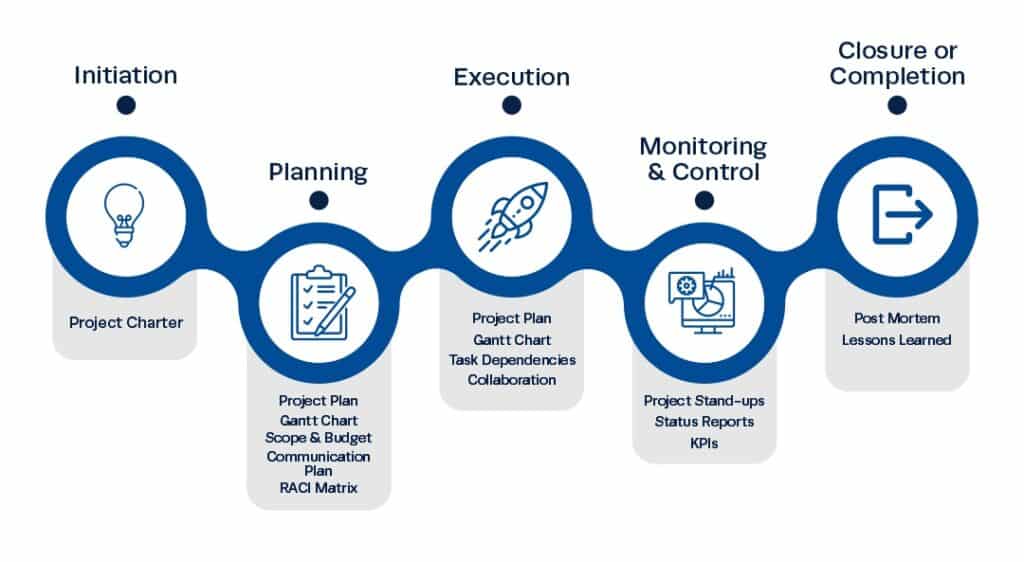One of the keys to running a successful business is funding high-value projects. However, funding these projects can be tricky if you need to learn how to budget them properly.
A budgeting tool can help with the calculations, but it’s still imperative to understand all the different facets of budget management.
The good news is that learning how to construct and handle a budget is quite approachable when you stick to the right steps. And guess what? We’re right here to guide you through those very steps, starting right now.
So, without further ado, let’s dive into the vital insights you need to master the realm of project budget management.
- What is Project Budget Management?
- Why Is Managing a Project Budget Important?
- Methods of Project Budgeting
- The Role of Project Manager in Budgeting
- Calculating the Project Budget: A Practical Example
- Upgrade Your Project Budgeting With Rock Content’s Budgeting Tool
What is Project Budget Management?
Project budget management is developing a budget for a specific project based on various factors. While the total budget is essential, the individual elements and cost expectations are also crucial.
Managing a budget means understanding each component and why it will cost a specific amount. Although you may be working with estimations and unknown variables, success is getting as close to the correct number as possible.
Why Is Managing a Project Budget Important?
Suppose you were to develop a digital marketing budget for a specific campaign. If you were to request a sum of money (i.e., $15,000), you don’t necessarily know if it’s enough to achieve the project’s unique goals.
For example, if the marketing campaign is designed to boost subscriber numbers, how many new subscribers could you expect to capture with $15,000? What if you need more? What if $15,000 doesn’t generate any return?
Project budget management helps ensure you align the costs with the right goals and verify that you’ll receive a decent ROI on the investment.
Without this process, you’re essentially burning through cash without understanding whether it’s worth it. For example, what if you spent $15,000 and only captured 100 subscribers? What if none of those subscribers converted into customers? That’s money down the drain with nothing to show for it.
Methods of Project Budgeting
Knowing the value of project budget management differs from putting those ideas into action. Instead, it’s best to utilize different budgeting methods to ensure you get an accurate number.
Also, knowing why you’re spending money on a particular line item is essential, particularly when pitching the budget to your boss.
Here are four methods of project budgeting that you can use to craft detailed and accurate budgets for each project.
Traditional Cost Estimation
Unless your business is a startup with little historical data, you can likely use traditional cost estimation to get an idea of what your budget should be.
In this case, you pay attention to the budgets of previous projects with similar goals or processes to see whether they were accurate.
If previous budgets went overboard, you must look at why to see how to avoid the same mistakes. If the earlier projects came in under budget, you need to see whether there were missed opportunities that you can take advantage of this time.
Other types of traditional cost estimation include:
- Top-Down Estimation – In this case, the higher-ups determine the maximum budget, and the project manager works within those parameters to source costs for individual tasks.
- Bottom-Up Estimation – In this method, you start by estimating the costs of individual tasks or components needed to complete the project and then aggregate these estimates. For example, you might invest in a higher-cost product if it yields a better return.
Parametric Estimation
Parametric estimation is looking at historical data and applying modern cost analysis. For example, let’s say there was a task that took two employees 20 hours each. The total cost for that task was roughly $800, assuming $20 per hour per employee.
If you need to accomplish an identical or similar task, you may assume that $800 is a reasonable budget estimation. However, you must look at current data to determine whether that number is accurate. For example, if workers make $25/hour, the minimum may be $1,000, not $800.
That said, you also have to look at the efficiency of the task. Are there tools available now that can reduce the required hours? The employees can use an AI assistant to do the work in half the time. So, even if they’re making a higher hourly wage, your budget can come down to $500 (25 x 10 x 2).
This estimation strategy can take longer to process (especially if you don’t have exact data available), but it can be much more accurate. Typically, parametric estimation is used for construction, engineering, and life sciences, but it could also apply to other businesses.
Three-Point Estimation
If you’ve ever managed a project, you know that plans can go awry for several reasons. However, while problems can occur, sometimes the opposite happens.
Sometimes, you may wind up ahead of schedule and under budget. What will you and your team do with the extra time and money if that occurs?
Since you want it to be of good use, you should have a backup plan to exceed the project’s goals or to start work on another project.
This is the foundation of the three-point estimation method. On one side, you estimate a “worst-case” scenario. For example, costs may balloon because more people are required or materials are more expensive than before.
While it’s easy to tack on extra numbers, you want your worst-case budget to remain accurate.
Conversely, you have a “best-case” scenario where tasks are completed early, and everything comes under budget. In the middle, you have a “realistic” scenario, which can be based on historical data or other factors.
This method is valuable because you can bring three options to those in charge. This way, if the worst does happen, they know what to expect, at least financially speaking.
Reserve Analysis
Since delays and problems can happen, it’s often better to budget for them than to hope they don’t occur. Reserve analysis involves planning the budget and then adding reserve resources on top of that. These reserves are for when a task takes longer than necessary or some materials cost more than estimated.
Knowing that a reserve analysis is not the same as a “worst-case” budget estimation is essential. These reserves can smooth out wrinkles, but not exactly right a sinking ship.
Usually, project managers will add another five to 10 percent of the total budget as a reserve, but you can get more detailed than that. Instead, you can look at specific tasks that will likely require more people or materials and add reserve estimates. In most cases, it’s easy to see where the project could get bogged down or fall behind.
The Role of Project Manager in Budgeting
Although a project manager may not be directly responsible for creating the budget, their influence is crucial in ensuring effective budget management throughout the project lifecycle.
Collaborating closely with the budgeting team, the project manager brings valuable insights to the table, enhancing the accuracy of estimations and financial planning. This collaboration extends beyond numbers; the project manager might advocate for additional funding for specific tasks or propose resource optimization to achieve more with less.
The integration of the project manager into the budgeting process equips them with a comprehensive understanding of financial constraints. This insight empowers them to make informed decisions, adjust strategies, and allocate resources efficiently to stay on track.
Moreover, a knowledgeable project manager who is well-versed in the estimated costs of individual resources or tasks is strategically positioned to align project activities with budgetary limits. By fostering this synergy between budget and execution, the project manager plays a pivotal role in safeguarding the project’s financial success.

Calculating the Project Budget: A Practical Example
So far, we’ve been dealing with abstract concepts, but let’s look at some tangible, real-world elements to understand how budgeting works. Here is a step-by-step guide for a digital marketing project budget.
Project Goals – To increase leads and conversion rates. The company wants to go from 100 to 200 leads per month within three months. The current conversion rate is 1.5 percent, and the company wants to boost that to five percent within the same period.
Project Timeline – Three to six months, although management would like to aim for three.
Project Elements – Digital marketing requires a multipronged approach, with elements like:
- Blog Posts
- Video Clips
- Infographics
- Social Media Posts
- Whitepapers and E-books
- Landing Pages
- SEO
- Paid Advertising
So, when creating the budget, you’ll have to put a price on each of these elements, such as:
- Blog Posts – $100 per post
- Video Clips – $500 per clip
- Infographics – $150 per infographic
- Social Media Posts – $100 for ten posts
- White Papers and E-Books – $250 for each
- Landing Pages – $100 per page
- SEO – $500/month
- Paid Advertising – $1 per click
If you only did one of each element and paid for SEO for three months, the total budget would be $2,700 for three months, not including any paid advertising.
However, your project will realistically need multiple elements to achieve its goals. For example, one blog post per week, two video clips, one infographic, ten social media posts per business day, two e-books, and five landing pages.
That budget report would look like this:
- Blog Posts – $1,200 (4 weeks x 3 months)
- Video Clips – $3,000
- Infographics – $450
- Social Media Posts – $6,000
- E-books – $500
- Landing Pages – $500
- SEO – $1,500
The total budget would become $13,150 if you did everything in-house based on those numbers. You could also work with a digital marketing agency that could develop everything for you for a flat monthly rate. In this case, your budgeting must be based on paid advertising.
In most cases, throwing more money at ads will generate fewer leads or conversions. Instead, testing and refining ads until they have a decent conversion rate is better than increasing the budget. Also, it matters which keywords you’re paying for, as some are far more competitive (and require more money) than others.
Finally, as you work on the project and release different marketing materials, you may discover that some move the needle more than others. For example, blog posts may generate the majority of your traffic, while infographics don’t do anything. Based on this data, you can cut the infographics from the budget and use that money for more blogs or paid ads (or trim from your budget total).
Upgrade Your Project Budgeting With Rock Content’s Budgeting Tool
As you can see, project budget management can be complicated, mainly if you’re working toward abstract variables. For example, you can tell when you’re boosting your conversion rate, but it’s sometimes apparent what is doing that, so you must make educated guesses.
Fortunately, Rock Content can help streamline the budgeting process with our free budgeting planner. It will calculate your overall marketing budget needs so you can achieve your goals.
Whether you’re a brand-new business or an enterprise company looking to expand to new markets, this planner is valuable. The Rock Content team can also help create content and digital marketing assets to supercharge your campaigns and see results faster.
Check out this tool and see how Rock Content can help improve your business!







